LoRaWAN™ 1.0.3 Specification
Copyright © 2018 LoRa Alliance, Inc. All rights reserved.
NOTICE OF USE AND DISCLOSURE
Copyright © LoRa Alliance, Inc. (2017). All Rights Reserved.
The information within this document is the property of the LoRa Alliance (“The Alliance”) and its use and disclosure are
subject to LoRa Alliance Corporate Bylaws, Intellectual Property Rights (IPR) Policy and Membership Agreements.
Elements of LoRa Alliance specifications may be subject to third party intellectual property rights, including without
limitation, patent, copyright or trademark rights (such a third party may or may not be a member of LoRa Alliance). The
Alliance is not responsible and shall not be held responsible in any manner for identifying or failing to identify any or all
such third party intellectual property rights.
This document and the information contained herein are provided on an “AS IS” basis and THE ALLIANCE DISCLAIMS
ALL WARRANTIES EXPRESS OR IMPLIED, INCLUDING BUT NOTLIMITED TO (A) ANY WARRANTY THAT
THE USE OF THE INFORMATION HEREINWILL NOT INFRINGE ANY RIGHTS OF THIRD PARTIES
(INCLUDING WITHOUTLIMITATION ANY INTELLECTUAL PROPERTY RIGHTS INCLUDING PATENT,
COPYRIGHT OR TRADEMARK RIGHTS) OR (B) ANY IMPLIED WARRANTIES OF MERCHANTABILITY,
FITNESS FOR A PARTICULAR PURPOSE,TITLE OR NONINFRINGEMENT.
IN NO EVENT WILL THE ALLIANCE BE LIABLE FOR ANY LOSS OF PROFITS, LOSS OF BUSINESS, LOSS OF
USE OF DATA, INTERRUPTION OFBUSINESS, OR FOR ANY OTHER DIRECT, INDIRECT, SPECIAL OR
EXEMPLARY, INCIDENTIAL, PUNITIVE OR CONSEQUENTIAL DAMAGES OF ANY KIND, IN CONTRACT OR
IN TORT, IN CONNECTION WITH THIS DOCUMENT OR THE INFORMATION CONTAINED HEREIN, EVEN IF
ADVISED OF THE POSSIBILITY OF SUCH LOSS OR DAMAGE.
The above notice and this paragraph must be included on all copies of this document that are made.
LoRa Alliance, Inc.
3855 SW 153rd Drive
Beaverton, OR 97007
Note: All Company, brand and product names may be trademarks that are the sole property of their respective owners.
1
2
3
4
5
6
7
8
9
10
11
12
13
14
15
16
17
18
19
20
21
22
23
24
25
26
27
28
29
30
31
32
33
34
35
36
37
38
©2018 LoRa™ Alliance
Page 1 of 74
The authors reserve the right to change
specifications without notice.
�
LoRaWAN 1.0.3 Specification
LoRaWAN™ 1.0.3 Specification
Authored by the LoRa Alliance Technical Committee
Chairs:
N.SORNIN (Semtech), A.YEGIN(Actility)
Editor:
N.SORNIN(Semtech)
Contributors:
A.BERTOLAUD (Gemalto), J.CATALANO (Kerlink), J.DELCLEF (ST Microelectronics),
V.DELPORT (Microchip Technology), P.DUFFY (Cisco), F.DYDUCH (Bouygues Telecom),
T.EIRICH (TrackNet), L.FERREIRA (Orange), S.GHAROUT(Orange), O.HERSENT
(Actility), A.KASTTET (Homerider Systems), D.KJENDAL (Senet), V.KLEBAN (Everynet),
J.KNAPP (TrackNet), T.KRAMP (TrackNet), M.KUYPER (TrackNet), P.KWOK (Objenious),
M.LEGOURIEREC (Sagemcom), C.LEVASSEUR (Bouygues Telecom), M.LUIS (Semtech),
M.PAULIAC (Gemalto), P.PIETRI (Orbiwise), D.SMITH (MultiTech), R.SOSS(Actility),
T.TASHIRO (M2B Communications), P.THOMSEN (Orbiwise), A.YEGIN (Actility)
Version: V1.0.3
Date: March 20, 2018
Status: Final release
39
40
41
42
43
44
45
46
47
48
49
50
51
52
53
54
55
56
57
58
59
60
61
62
63
64
©2018 LoRa™ Alliance
Page 2 of 74
The authors reserve the right to change
specifications without notice.
�
LoRaWAN 1.0.3 Specification
65
66
67
68
69
70
71
72
73
74
75
76
77
78
79
80
81
82
83
84
85
86
87
88
89
90
91
92
93
94
95
96
97
98
99
100
101
102
103
104
105
106
107
108
109
110
111
112
113
114
4
5
Contents
1
2
Introduction .................................................................................................................. 7
1.1 LoRaWAN Classes .................................................................................................. 7
1.2 Conventions ............................................................................................................. 8
Introduction on LoRaWAN options ............................................................................... 9
2.1 LoRaWAN Classes .................................................................................................. 9
2.2 Specification scope ................................................................................................ 10
Class A – All end-devices ................................................................................................... 11
Physical Message Formats ........................................................................................ 12
3
3.1 Uplink Messages .................................................................................................... 12
3.2 Downlink Messages ............................................................................................... 12
3.3 Receive Windows................................................................................................... 12
3.3.1 First receive window channel, data rate, and start ............................................ 13
3.3.2 Second receive window channel, data rate, and start ....................................... 13
3.3.3 Receive window duration .................................................................................. 13
3.3.4 Receiver activity during the receive windows .................................................... 13
3.3.5 Network sending a message to an end-device ................................................. 13
3.3.6
Important notice on receive windows ................................................................ 14
3.3.7 Receiving or transmitting other protocols .......................................................... 14
MAC Message Formats ............................................................................................. 15
4.1 MAC Layer (PHYPayload) ...................................................................................... 15
4.2 MAC Header (MHDR field) ..................................................................................... 15
4.2.1 Message type (MType bit field) ......................................................................... 16
4.2.2 Major version of data message (Major bit field) ................................................ 16
4.3 MAC Payload of Data Messages (MACPayload) .................................................... 17
4.3.1 Frame header (FHDR) ...................................................................................... 17
4.3.2 Port field (FPort) ............................................................................................... 20
4.3.3 MAC Frame Payload Encryption (FRMPayload) ............................................... 21
4.4 Message Integrity Code (MIC)................................................................................ 21
MAC Commands........................................................................................................ 22
5.1 Link Check commands (LinkCheckReq, LinkCheckAns) ........................................ 23
5.2 Link ADR commands (LinkADRReq, LinkADRAns) ................................................ 24
5.3 End-Device Transmit Duty Cycle (DutyCycleReq, DutyCycleAns) .......................... 26
5.4 Receive Windows Parameters (RXParamSetupReq, RXParamSetupAns) ............ 26
5.5 End-Device Status (DevStatusReq, DevStatusAns) ............................................... 27
5.6 Creation / Modification of a Channel (NewChannelReq, NewChannelAns,
6
DlChannelReq, DlChannelAns) .............................................................................. 28
5.7 Setting delay between TX and RX (RXTimingSetupReq, RXTimingSetupAns) ...... 30
5.8 End-device transmission parameters (TxParamSetupReq, TxParamSetupAns) .... 30
5.9 DeviceTime commands (DeviceTimeReq, DeviceTimeAns) ................................... 31
End-Device Activation ................................................................................................ 33
6.1 Data Stored in the End-device after Activation ....................................................... 33
6.1.1 End-device address (DevAddr) ......................................................................... 33
6.1.2 Application identifier (AppEUI) .......................................................................... 33
6.1.3 Network session key (NwkSKey) ...................................................................... 33
6.1.4 Application session key (AppSKey) .................................................................. 33
6.2 Over-the-Air Activation ........................................................................................... 34
6.2.1 End-device identifier (DevEUI) ......................................................................... 34
6.2.2 Application key (AppKey) ................................................................................. 34
6.2.3 Join procedure.................................................................................................. 34
©2018 LoRa™ Alliance
Page 3 of 74
The authors reserve the right to change
specifications without notice.
�
115
116
117
118
119
120
121
122
123
124
125
126
127
128
129
130
131
132
133
134
135
136
137
138
139
140
141
142
143
144
145
146
147
148
149
150
151
152
153
154
155
156
157
158
159
160
161
162
163
164
165
166
167
LoRaWAN 1.0.3 Specification
6.2.4 Join-request message ...................................................................................... 34
6.2.5 Join-accept message........................................................................................ 35
6.3 Activation by Personalization ................................................................................. 37
7
Retransmissions back-off ........................................................................................... 38
Class B – Beacon ............................................................................................................... 39
8
Introduction to Class B ............................................................................................... 40
9
Principle of synchronous network initiated downlink (Class-B option) ......................... 41
10 Uplink frame in Class B mode .................................................................................... 44
11 Downlink Ping frame format (Class B option) ............................................................. 45
11.1 Physical frame format ............................................................................................ 45
11.2 Unicast & Multicast MAC messages ....................................................................... 45
11.2.1 Unicast MAC message format .......................................................................... 45
11.2.2 Multicast MAC message format ........................................................................ 45
12 Beacon acquisition and tracking ................................................................................. 46
12.1 Minimal beacon-less operation time ....................................................................... 46
12.2 Extension of beacon-less operation upon reception ............................................... 46
12.3 Minimizing timing drift ............................................................................................. 46
13 Class B Downlink slot timing ...................................................................................... 48
13.1 Definitions .............................................................................................................. 48
13.2 Slot randomization ................................................................................................. 49
14 Class B MAC commands ........................................................................................... 50
14.1 PingSlotInfoReq ..................................................................................................... 50
14.2 BeaconFreqReq ..................................................................................................... 51
14.3 PingSlotChannelReq .............................................................................................. 52
14.4 BeaconTimingReq & BeaconTimingAns ................................................................. 53
15 Beaconing (Class B option) ........................................................................................ 54
15.1 Beacon physical layer ............................................................................................ 54
15.2 Beacon frame content ............................................................................................ 54
15.3 Beacon GwSpecific field format .............................................................................. 55
15.3.1 Gateway GPS coordinate:InfoDesc = 0, 1 or 2 ................................................. 56
15.3.2 NetID+GatewayID ............................................................................................ 56
15.4 Beaconing precise timing ....................................................................................... 56
15.5 Network downlink route update requirements ......................................................... 57
16 Class B unicast & multicast downlink channel frequencies ......................................... 58
16.1 Single channel beacon transmission ...................................................................... 58
16.2 Frequency-hopping beacon transmission ............................................................... 58
Class C – Continuously listening ......................................................................................... 59
17 Class C: Continuously listening end-device................................................................ 60
17.1 Second receive window duration for Class C ......................................................... 60
17.2 Class C Multicast downlinks ................................................................................... 61
Support information ............................................................................................................. 62
18 Examples and Application Information ....................................................................... 63
18.1 Uplink Timing Diagram for Confirmed Data Messages ........................................... 63
18.2 Downlink Diagram for Confirmed Data Messages .................................................. 63
18.3 Downlink Timing for Frame-Pending Messages ..................................................... 64
18.4 Data-Rate Adaptation during Message Retransmissions........................................ 65
19 Recommendation on contract to be provided to the network server by the end-
device provider at the time of provisioning .......................................................................... 67
20 Recommendation on finding the locally used channels .............................................. 68
21 Revisions ................................................................................................................... 69
21.1 Revision 1.0 ........................................................................................................... 69
21.2 Revision 1.0.1 ........................................................................................................ 69
21.3 Revision 1.0.2 ........................................................................................................ 69
©2018 LoRa™ Alliance
Page 4 of 74
The authors reserve the right to change
specifications without notice.
�
LoRaWAN 1.0.3 Specification
21.4 Revision 1.0.3 ........................................................................................................ 70
22 Glossary .................................................................................................................... 71
23 Bibliography ............................................................................................................... 72
23.1 References............................................................................................................. 72
24 NOTICE OF USE AND DISCLOSURE ....................................................................... 73
Tables
Table 1: PHY payload format .............................................................................................. 15
Table 2: MAC message types ............................................................................................. 16
Table 3: Major list ................................................................................................................ 16
Table 4: FPort list ................................................................................................................ 21
Table 5: MAC commands .................................................................................................... 23
Table 6: Channel state table ............................................................................................... 24
Table 7: LinkADRAns status bits signification ..................................................................... 26
Table 8: RX2SetupAns status bits signification ................................................................... 27
Table 9: Battery level decoding ........................................................................................... 27
Table 10: NewChannelAns status bits signification ............................................................. 29
Table 11: DlChannelAns status bits signification ................................................................. 30
Table 12: Del mapping table ............................................................................................... 30
Table 13: Beacon timing ..................................................................................................... 48
Table 14 : Class B slot randomization algorithm parameters ............................................... 49
Table 15 : Class B MAC command table ............................................................................. 50
Table 16 : beacon infoDesc index mapping ......................................................................... 55
168
169
170
171
172
173
174
175
176
177
178
179
180
181
182
183
184
185
186
187
188
189
190
191
192
193
194
195
196
197
198
199
200
201
202
203
204
205
206
207
208
209
210
211
212
213
214
Figures
Figure 1: LoRaWAN Classes ................................................................................................ 9
Figure 2: Uplink PHY structure ............................................................................................ 12
Figure 3: Downlink PHY structure ....................................................................................... 12
Figure 4: End-device receive slot timing. ............................................................................. 13
Figure 5: Radio PHY structure (CRC* is only available on uplink messages) ...................... 15
Figure 6: PHY payload structure ......................................................................................... 15
Figure 7: MAC payload structure ......................................................................................... 15
Figure 8: Frame header structure ........................................................................................ 15
Figure 9: LoRa message format elements ........................................................................... 15
Figure 11 : DeviceTimeAns payload format ......................................................................... 32
Figure 12: Beacon reception slot and ping slots .................................................................. 43
Figure 13 : class B FCtrl fields ............................................................................................ 44
Figure 14 : beacon-less temporary operation ...................................................................... 46
Figure 15: Beacon timing .................................................................................................... 48
Figure 16 : PingSlotInfoReq payload format ........................................................................ 50
Figure 17 : BeaconFreqReq payload format ........................................................................ 51
Figure 18 : BeaconFreqAns payload format ........................................................................ 51
Figure 19 : PingSlotChannelReq payload format ................................................................. 52
Figure 20 : PingSlotFreqAns payload format ....................................................................... 52
Figure 21 : beacon physical format ..................................................................................... 54
Figure 22 : beacon frame content........................................................................................ 54
Figure 23 : example of beacon CRC calculation (1) ............................................................ 54
©2018 LoRa™ Alliance
Page 5 of 74
The authors reserve the right to change
specifications without notice.
�
LoRaWAN 1.0.3 Specification
215
216
217
218
219
220
221
222
223
224
225
Figure 24 : example of beacon CRC calculation (2) ............................................................ 55
Figure 25 : beacon GwSpecific field format ......................................................................... 55
Figure 26 : beacon Info field format , infoDesc = 0,1,2 ........................................................ 56
Figure 27 : beacon Info field format, infoDesc=3 ................................................................. 56
Figure 28: Class C end-device reception slot timing. ........................................................... 61
Figure 29: Uplink timing diagram for confirmed data messages .......................................... 63
Figure 30: Downlink timing diagram for confirmed data messages ...................................... 64
Figure 31: Downlink timing diagram for frame-pending messages, example 1 .................... 64
Figure 32: Downlink timing diagram for frame-pending messages, example 2 .................... 65
Figure 33: Downlink timing diagram for frame-pending messages, example 3 .................... 65
©2018 LoRa™ Alliance
Page 6 of 74
The authors reserve the right to change
specifications without notice.
�
226
227
228
229
230
231
232
233
234
235
236
237
238
239
240
241
242
243
244
245
246
247
248
249
250
251
252
253
254
255
256
257
258
1
Introduction
LoRaWAN 1.0.3 Specification
This document describes the LoRaWAN™ network protocol which is optimized for battery-
powered end-devices that may be either mobile or mounted at a fixed location.
LoRaWAN networks typically are laid out in a star-of-stars topology in which gateways1
relay messages between end-devices2 and a central network server at the backend.
Gateways are connected to the network server via standard IP connections while end-
devices use single-hop LoRa™ or FSK communication to one or many gateways.3 All
communication is generally bi-directional, although uplink communication from an end-
device to the network server is expected to be the predominant traffic.
Communication between end-devices and gateways is spread out on different frequency
channels and data rates. The selection of the data rate is a trade-off between
communication range and message duration, communications with different data rates do
not interfere with each other. LoRa data rates range from 0.3 kbps to 50 kbps. To maximize
both battery life of the end-devices and overall network capacity, the LoRa network
infrastructure can manage the data rate and RF output for each end-device individually by
means of an adaptive data rate (ADR) scheme.
End-devices may transmit on any channel available at any time, using any available data
rate, as long as the following rules are respected:
The end-device changes channel
for every
transmission. The resulting frequency diversity makes the system more robust to
interferences.
in a pseudo-random
fashion
The end-device respects the maximum transmit duty cycle relative to the sub-band
used and local regulations.
The end-device respects the maximum transmit duration (or dwell time) relative to
the sub-band used and local regulations.
Note: Maximum transmit duty-cycle and dwell time per sub-band are
region specific and are defined in the LoRaWAN ¨regional phyLayer
definition document
1.1 LoRaWAN Classes
All LoRaWAN devices implement at least the Class A functionality as described in this
document. In addition they MAY implement options named Class B, Class C as also
described in this document or others to be defined. In all cases, they must remain
compatible with Class A.
1 Gateways are also known as concentrators or base stations.
2 End-devices are also known as motes.
3 Support for intermediate elements – repeaters – is not described in the document, however payload
restrictions for encapsulation overhead are included in this specification. A repeater is defined as
using LoRaWAN as its backhaul mechanism.
©2018 LoRa™ Alliance
Page 7 of 74
The authors reserve the right to change
specifications without notice.
�
LoRaWAN 1.0.3 Specification
259
260
261
1.2 Conventions
MAC commands are written LinkCheckReq, bits and bit fields are written FRMPayload,
constants are written RECEIVE_DELAY1, variables are written N.
262
In this document,
263
264
265
The octet order for all multi-octet fields is little endian and
EUI are 8 bytes multi-octet fields and are transmitted as little endian.
By default, RFU bits are set to zero
©2018 LoRa™ Alliance
Page 8 of 74
The authors reserve the right to change
specifications without notice.
�
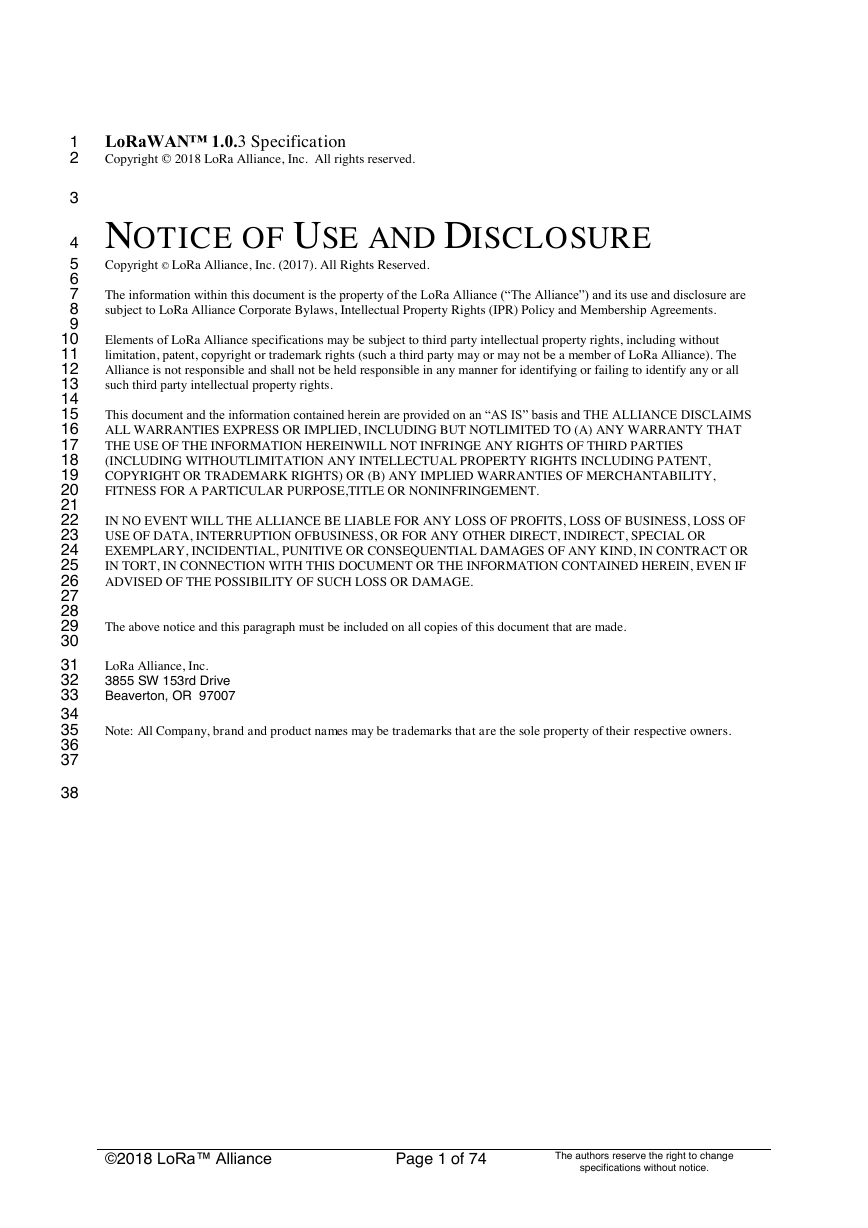
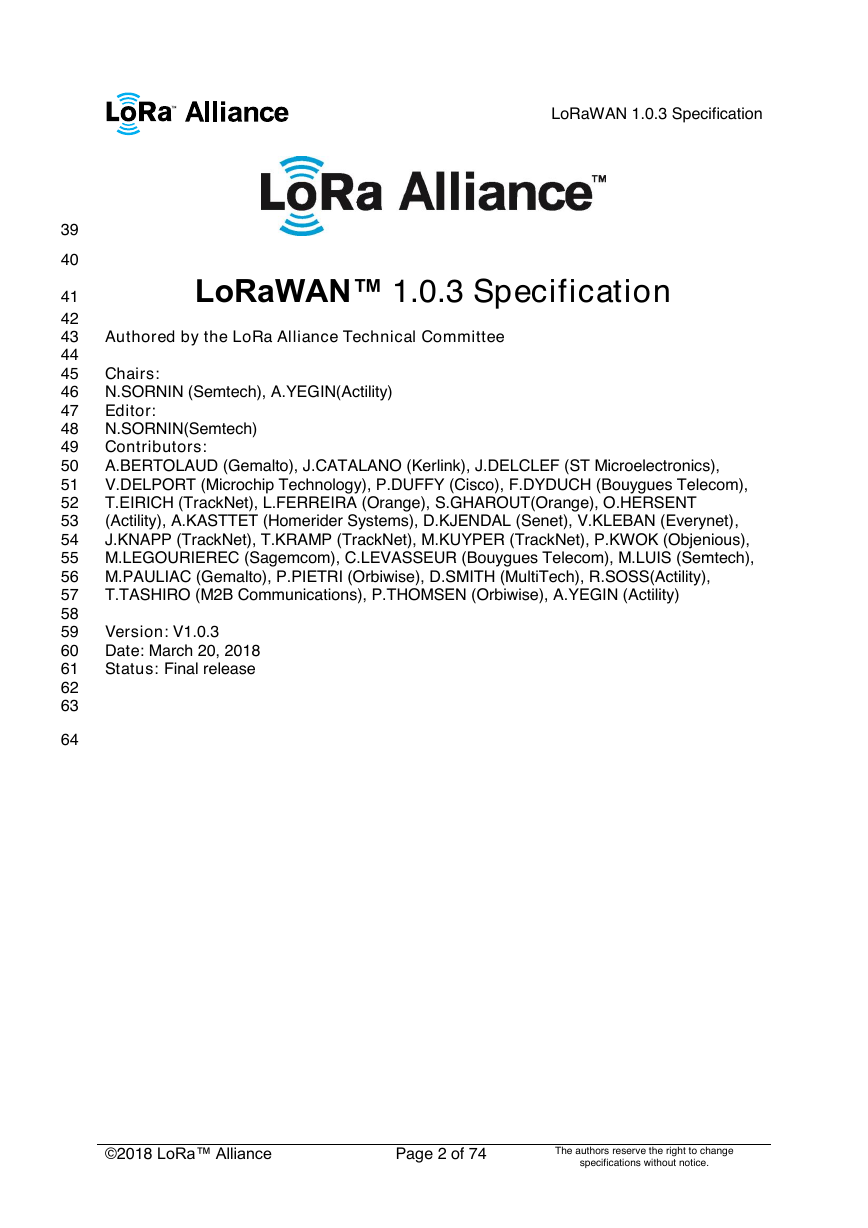
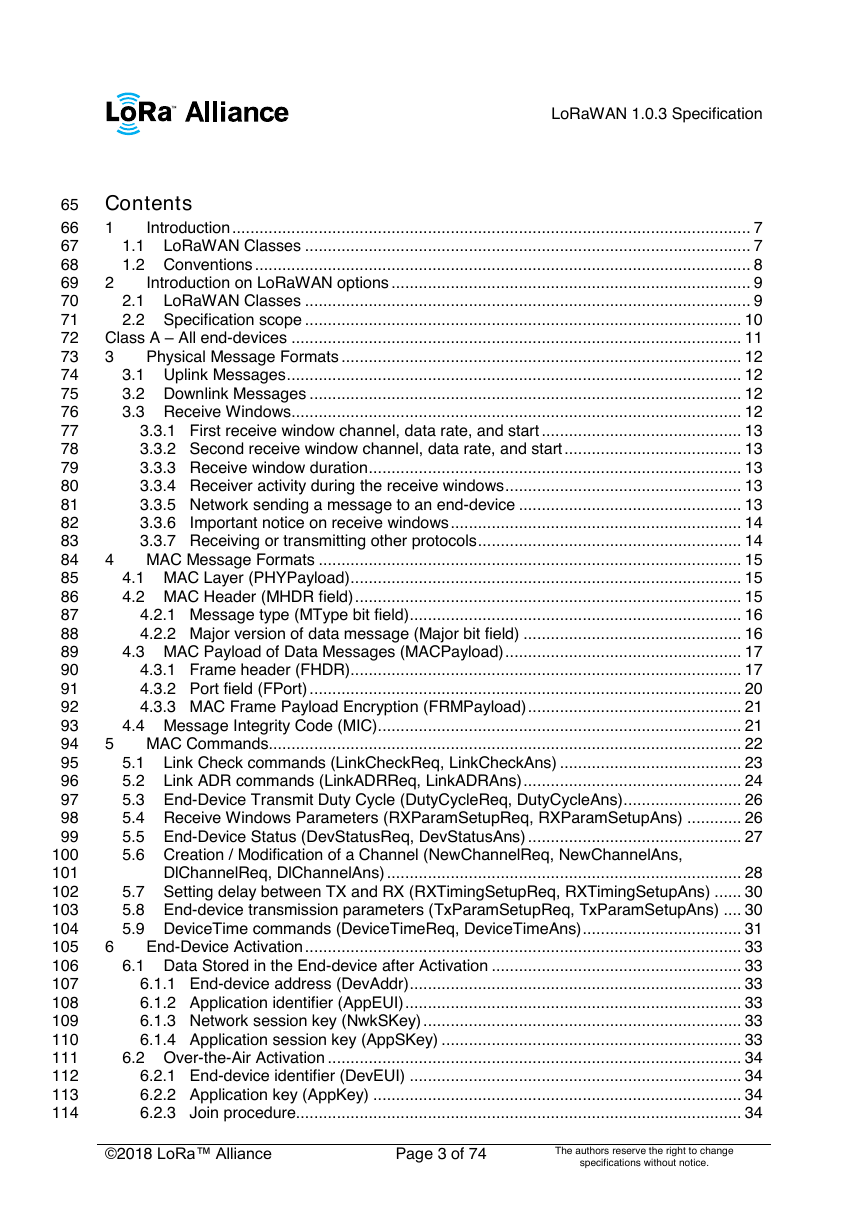
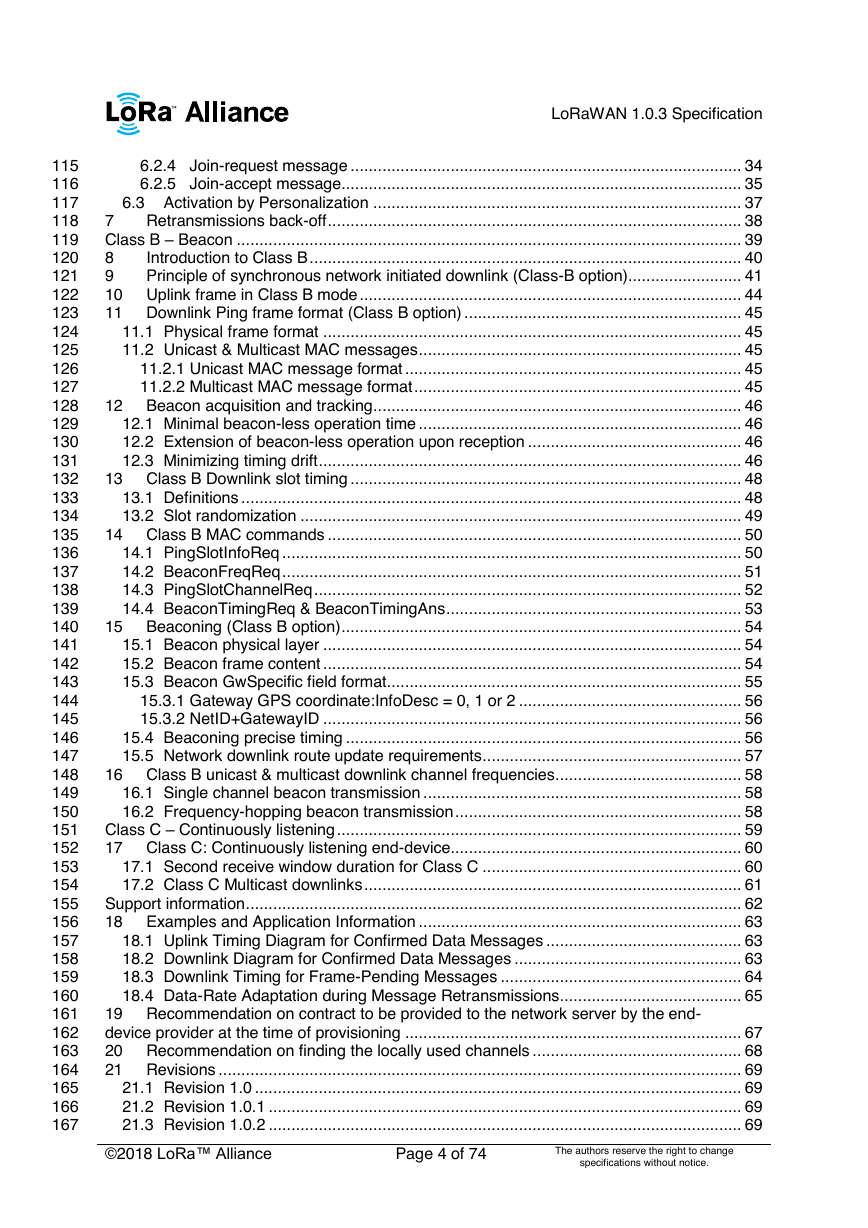
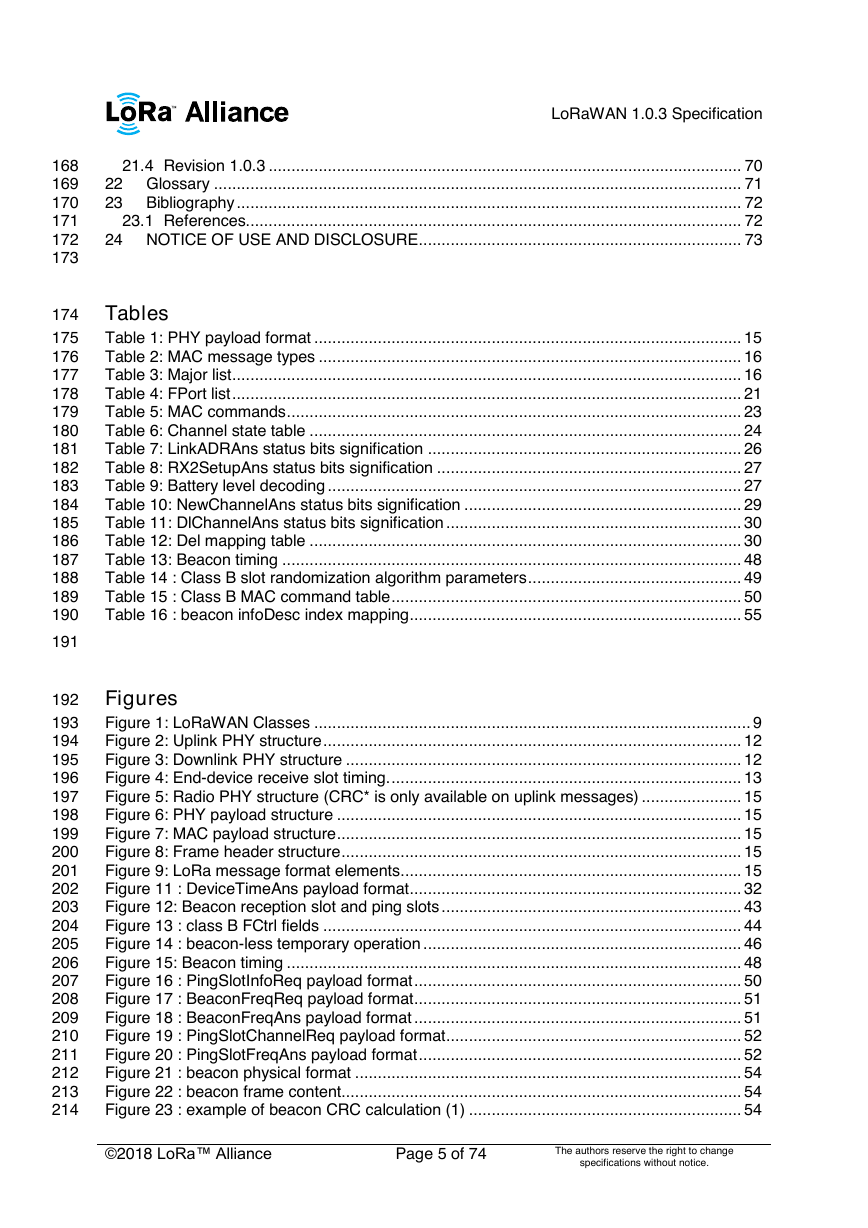

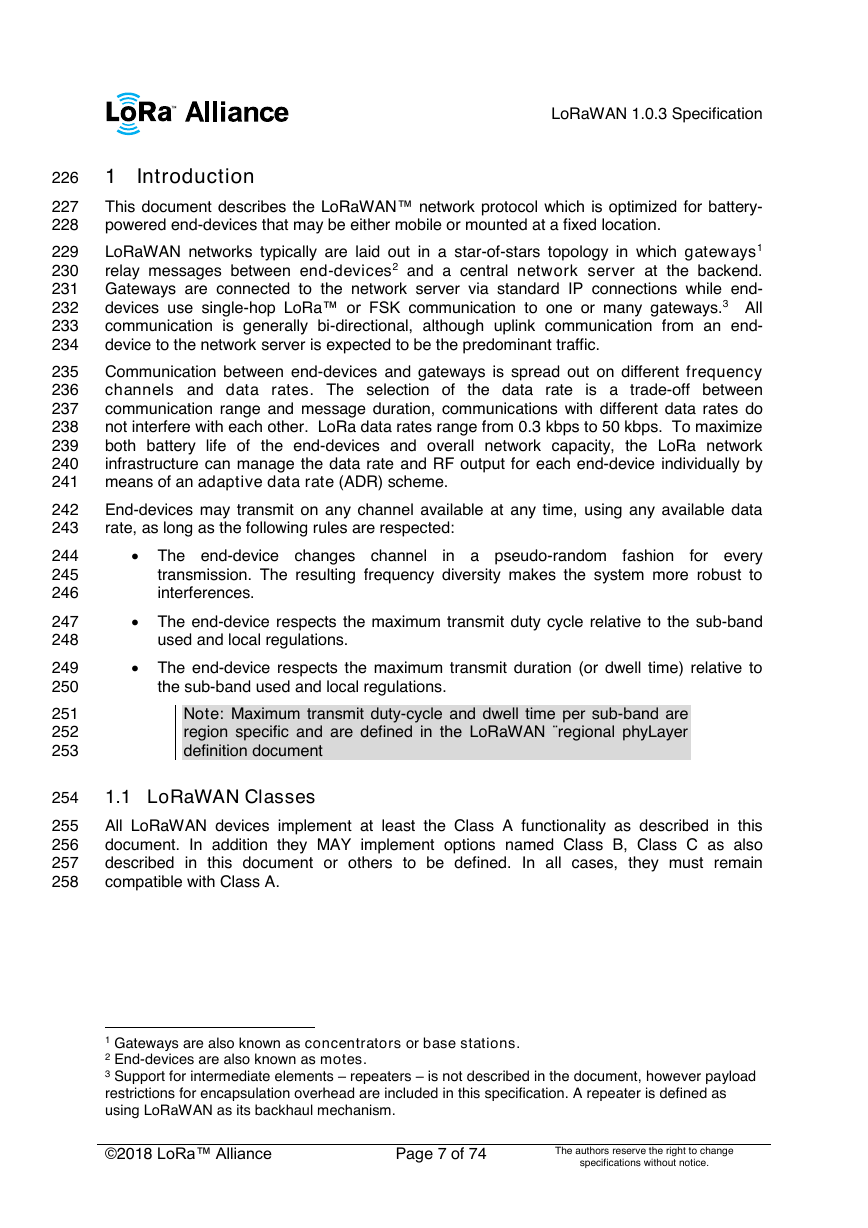
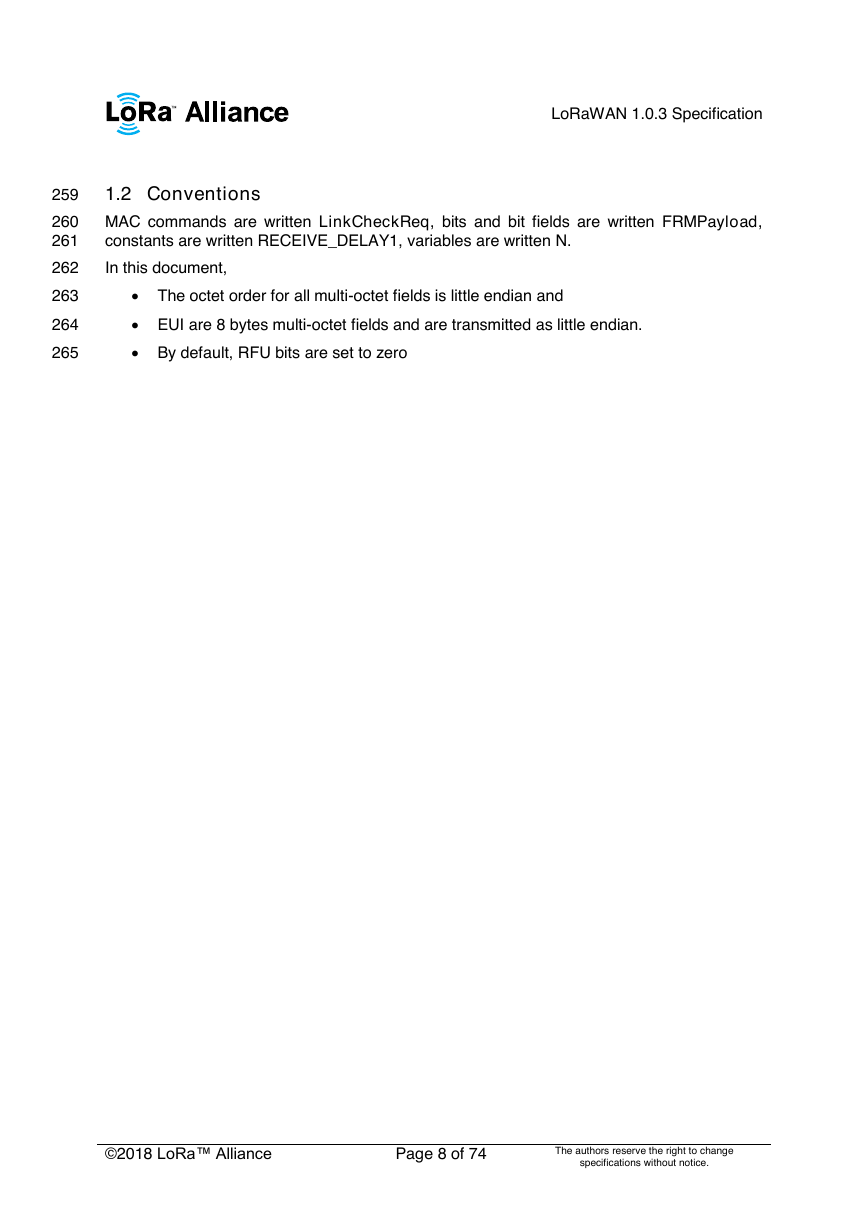








 2023年江西萍乡中考道德与法治真题及答案.doc
2023年江西萍乡中考道德与法治真题及答案.doc 2012年重庆南川中考生物真题及答案.doc
2012年重庆南川中考生物真题及答案.doc 2013年江西师范大学地理学综合及文艺理论基础考研真题.doc
2013年江西师范大学地理学综合及文艺理论基础考研真题.doc 2020年四川甘孜小升初语文真题及答案I卷.doc
2020年四川甘孜小升初语文真题及答案I卷.doc 2020年注册岩土工程师专业基础考试真题及答案.doc
2020年注册岩土工程师专业基础考试真题及答案.doc 2023-2024学年福建省厦门市九年级上学期数学月考试题及答案.doc
2023-2024学年福建省厦门市九年级上学期数学月考试题及答案.doc 2021-2022学年辽宁省沈阳市大东区九年级上学期语文期末试题及答案.doc
2021-2022学年辽宁省沈阳市大东区九年级上学期语文期末试题及答案.doc 2022-2023学年北京东城区初三第一学期物理期末试卷及答案.doc
2022-2023学年北京东城区初三第一学期物理期末试卷及答案.doc 2018上半年江西教师资格初中地理学科知识与教学能力真题及答案.doc
2018上半年江西教师资格初中地理学科知识与教学能力真题及答案.doc 2012年河北国家公务员申论考试真题及答案-省级.doc
2012年河北国家公务员申论考试真题及答案-省级.doc 2020-2021学年江苏省扬州市江都区邵樊片九年级上学期数学第一次质量检测试题及答案.doc
2020-2021学年江苏省扬州市江都区邵樊片九年级上学期数学第一次质量检测试题及答案.doc 2022下半年黑龙江教师资格证中学综合素质真题及答案.doc
2022下半年黑龙江教师资格证中学综合素质真题及答案.doc